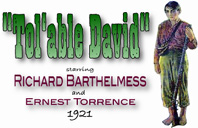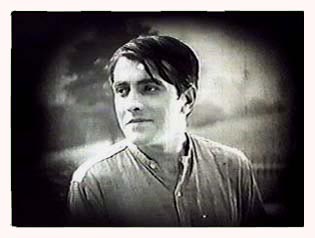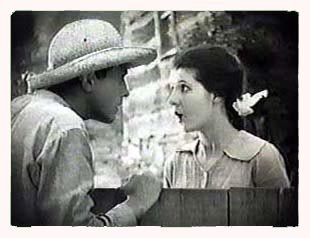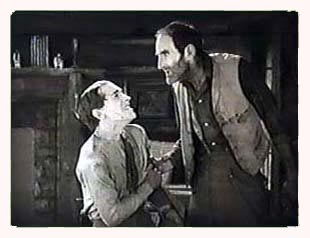

Inspiration Pictures
cast: Richard Barthelmess (David Kinemon), Gladys Hulette (Esther Hatburn), Ernest Torrance (Luke Hatburn), Edmund Goulding (Hunter Kinemon), Warner Richmond (Allan Kinemon), Marion Abbott (Mrs. Kinemon), Forrest Robinson (Grandfather Hatburn), Walter Lewis (Iska Hatburn), Ralph Yearsley ("Buzzard" Hatburn), Lawrence Eddinger (John Galt)
Many of us who love silent film know the delight, at a film convention or just a dinner gathering, of comparing notes on our favorites. Let someone mention BEN-HUR or THE GENERAL, and the response may be a nod, raised eyebrows, or a comment such as "Now THERE'S a film!" But I've found through the years that when I mention my personal favorite, TOL'ABLE DAVID (1921), the response is invariably a rapturous smile, eyes closed in bliss, and a sighed "I LOVE that picture!"
By all accounts the best film of director
Henry King's long career, TOL'ABLE DAVID inspires deep and abiding
affection even from those who generally don't like silents. Consider
the British critic David Shipman, who has written knowledgeably
on film stars for many years. While granting the rich legacy of
Chaplin and Keaton, Shipman holds that "Few other Silent
films yield much except to buffs (in which respect of course they're
like pre-Elizabethan drama). The so-called classics were lauded
for what they attempted rather than achieved-both because this
was a medium which, for the first time in history, could communicate
to millions and because it was denied the privilege of Sound.
Everything--not only the sets--seemed made of  cardboard
and if there was any character development it was in the crudest
terms."
cardboard
and if there was any character development it was in the crudest
terms."
Harsh words, these. But Shipman does give credit to at least one non-comic masterpiece from the period: "TOL'ABLE DAVID, directed by Henry King, [is] probably the least crude, the most fresh and moving, of any silent [drama]." And in his assessment of Richard Barthelmess, the film's star, Shipman pinpoints the appeal not only of the young Barthelmess, but of the film itself.
"It is improbable that many people, looking at a photograph of him, would agree that Richard Barthelmess 'had the most beautiful face of any man who ever went before the camera,' as Lillian Gish asserts in her memoirs. His face is round, pasty, and undistinguished, though he had large, sombre eyes and good blunt features . . . . at least he was and is unprepossessing in stills. But the motion-picture camera caught the beauty, an inner beauty, spiritual; not always, but certainly in TOL'ABLE DAVID and BROKEN BLOSSOMS, Barthelmess gave startingly beautiful performances: he was PURE."
Such is the operative word: pure. TOL'ABLE DAVID, like the best of D. W. Griffith's rural films (TRUE HEART SUSIE, say, and WAY DOWN EAST), shines even now because its warmth and humanity are unsullied by spectacle, dizzying special effects, or any other bells and whistles that have sometimes sometimes signalled American filmmaking at its most synthetic. It is--to borrow an opening title from WAY DOWN EAST--a simple story of plain people. The film's lovely rural ambience unfolds quietly and leisurely; we might well be watching a nineteenth-century daguerreotype set in motion.
Taken from a short story in Joseph Hergesheimer's
collection THE HAPPY LIFE (1919), TOL'ABLE DAVID is set in the
hills of Virginia, where Henry King himself grew up. David Kinemon
(Barthelmess), who lives with his family on a farm in the village
of Greenstream, enjoys the idylls of boyhood as  he
takes early-morning dips in the swimming hole; plays mumblety-peg;
pines for Esther (Gladys Hulette), the girl next door; and idolizes
his older brother Allan (Warner Richmond), the mail carrier for
Greenstream. When the degenerate Hatburn clan (led by Ernest Torrance)
come to town, however, they swiftly leave David's older brother
crippled for life and his father dead of a heart attack. Unable
to avenge his family lest he put his own life in peril, David
soon is entrusted to drive the mail hack--a daring contract for
this adolescent, for, as King commented years later, "People
don't realize in a small town . . . that to drive the hack to
carry the U. S. Mail was a responsibility -- the biggest responsibility
there was." But that trust is thwarted when Luke Hatburn
(Torrance) steal the mail. In his ensuing showdown with the Hatburns
("I'm the Goverment's agent . . . and David Kinemon too."),
risking his life for both his family and Greenstream, David grows
painfully, even agonizingly, to his maturity. In the lovely scene
that ends the film, when a battered and exahusted David tells
Esther that he's "tol'able, just tol'able," Mrs. Kinemon
raises her face to the heavens and says, "A man, my David!"
or "Amen, my David!"-- lipreaders will have a field
day arguing which. Either declaration fits.
he
takes early-morning dips in the swimming hole; plays mumblety-peg;
pines for Esther (Gladys Hulette), the girl next door; and idolizes
his older brother Allan (Warner Richmond), the mail carrier for
Greenstream. When the degenerate Hatburn clan (led by Ernest Torrance)
come to town, however, they swiftly leave David's older brother
crippled for life and his father dead of a heart attack. Unable
to avenge his family lest he put his own life in peril, David
soon is entrusted to drive the mail hack--a daring contract for
this adolescent, for, as King commented years later, "People
don't realize in a small town . . . that to drive the hack to
carry the U. S. Mail was a responsibility -- the biggest responsibility
there was." But that trust is thwarted when Luke Hatburn
(Torrance) steal the mail. In his ensuing showdown with the Hatburns
("I'm the Goverment's agent . . . and David Kinemon too."),
risking his life for both his family and Greenstream, David grows
painfully, even agonizingly, to his maturity. In the lovely scene
that ends the film, when a battered and exahusted David tells
Esther that he's "tol'able, just tol'able," Mrs. Kinemon
raises her face to the heavens and says, "A man, my David!"
or "Amen, my David!"-- lipreaders will have a field
day arguing which. Either declaration fits.
Certainly the plot is simple. And therein lies one of the film's greatest strengths, for until the showdown between David and the Hatburns, little happens--little except some of the loveliest vignettes of American life ever put on film. King rightly insisted that TOL'ABLE DAVID be filmed in the mountains of Virginia and sent his assistant ahead to scout out locations, looking in particular for split-rail fences, before he himself followed and found all he needed within a six-mile radius in what is now Blue Grass, Virginia, some eighty miles from his birthplace. Cameraman Henry Cronjager glowingly photographed the rolling hills and foursquare farms of Blue Grass, and one of the many joys of the picture is that after seeing a few times, one can happily watch it for the scenery alone. Little of Cronjager's work survives, but this film is a beautiful testament to his talents--as it is to those of King, Barthelmess, and the rest of the company.
King allowed to Kevin Brownlow that "With part of that picture I relived the days of my boyhood," and authentic touches of the nineteenth-century mountain South saturate the film: the tradition of evening prayers; David and Esther taking their cows to pasture; the women of the family waving fly whisks of shredded newspaper over breakfast; boys hanging onto the back of the mail hack as it leaves Greenstream; a village dance in the schoolhouse, replete with musicians sawing away at their violin and banjo, shy swains approaching their sweetie pies, and men standing outdoors sharing a nip; a family's excitement at the arrival of a newborn; spearing for trout in a mountain stream; Esther's grandfather teasing her about going after David, rather than the trout; and a country doctor making his rounds on horseback. Though interiors were shot in New York, they match the mood and detail of the exteriors perfectly, for King and his production team were working from photographs of interiors in Blue Grass.
Walter Coppedge, in two superb essays on the film (see end notes), identifies TOL'ABLE DAVID as a pastoral: "The skies seem to be bluer in Greenstream, it is always summer, and the country flows with sparkling streams bordered with wild mint. Soft mountain light bathes the valley, and meadows dotted with grazing sheep roll up to the wooded crests . . . The pastoral is a form of nostalgia, the longing of one caught up in the complex life of the metropolis for a simpler time." The truth and sweet wistfulness of the film ensured rapturous reception both in America and abroad at a time when Hollywood was racked by the Arbuckle scandal, and former Kentucky country boy D. W. Griffith, who himself had once owned the rights to Hergesheimer's story, was moved to embrace and kiss Barthelmess following the film's opening. Griffith surely must have known that rural Americana would never be more movingly caught.
In keeping with the tranquil nature of the
pastoral, the acting here is a delight--restrained and composed.
Barthelmess, a sophisticated city slicker and  graduate
of Trinity College, is totally believable as a barefoot mountain
boy and looks a good ten years younger than his twenty-five years.
For all the vigor he puts into his portrayal (and his extended
fight with Torrance is brutally realistic), he -- like occasional
co-star Lillian Gish -- may be at his best in extended close-up.
Watch him as he gazes at Esther as she walks back to her farm
or as he looks down at his mother as she clasps his knees and
begs him not to avenge himself on the Hatburns: one immediately
understands Shipman's point about the camera's catching Barthelmess's
spirituality. Gladys Hulette is a soulful and innocent Esther;
like Barthelmess, she glows in quiet close-ups that focus attention
on her lovely eyes and porcelain skin. (One can sadly understand
why her career dried up with the advent of Clara Bow and other
jazz babies later in the decade.) The older actors (Edmund Gurney,
Marion Abbott, and Forrest Robinson), all stage veterans who successfully
scaled down their emoting for the camera, are similarly quiet
and believable. Watch Robinson, as Esther's grandfather, laugh
as Esther rebukes him for teasing her; this single reaction shot
is an endearing example of the understated performances that grace
the film.
graduate
of Trinity College, is totally believable as a barefoot mountain
boy and looks a good ten years younger than his twenty-five years.
For all the vigor he puts into his portrayal (and his extended
fight with Torrance is brutally realistic), he -- like occasional
co-star Lillian Gish -- may be at his best in extended close-up.
Watch him as he gazes at Esther as she walks back to her farm
or as he looks down at his mother as she clasps his knees and
begs him not to avenge himself on the Hatburns: one immediately
understands Shipman's point about the camera's catching Barthelmess's
spirituality. Gladys Hulette is a soulful and innocent Esther;
like Barthelmess, she glows in quiet close-ups that focus attention
on her lovely eyes and porcelain skin. (One can sadly understand
why her career dried up with the advent of Clara Bow and other
jazz babies later in the decade.) The older actors (Edmund Gurney,
Marion Abbott, and Forrest Robinson), all stage veterans who successfully
scaled down their emoting for the camera, are similarly quiet
and believable. Watch Robinson, as Esther's grandfather, laugh
as Esther rebukes him for teasing her; this single reaction shot
is an endearing example of the understated performances that grace
the film.
Ernest Torrance has been accused of chewing the scenery about as ravenously as he chews a wild onion in one scene, but this charge is off center. He is, after all, the Goliath to Barthelmess's David, and his role is not suited for minimalist acting. Quiet villany, such as that offered by Sam de Grasse in Fairbanks's ROBIN HOOD (1922), would not convey the meanness of this Neanderthal. Considering the norm (i.e., broad and then some) of his acting in most silents (remember his semaphoric Captain Hook in Brenon's PETER PAN?), even Torrance himself might well be credited with restraint.
 Since
no one else seems to have singled them out, I should add that
the good residents of Blue Grass, who serve as extras in the film,
play with the naturalness of veterans, as they well might: it's
easy to believe that they are merely going about their everyday
business.
Since
no one else seems to have singled them out, I should add that
the good residents of Blue Grass, who serve as extras in the film,
play with the naturalness of veterans, as they well might: it's
easy to believe that they are merely going about their everyday
business.
For years TOL'ABLE DAVID circulated in a speeded-up, somewhat murky version from Viking Video and an arthritically slow (Remember, it's "Accu-Speed"!), funeral-organ accompanied version from Video Yesteryear. But here is proof that silent buffs' prayers are answered yet: scrubbed and remounted by a restoration from David Shepard for Film Preservation Associates, this jewel is now available on both video and DVD from Kino Video and on laserdisc from Image Entertainment. I do have two small quibbles with this restoration: there are several brief but crucial shots missing (both of Warner Richmond's grimaces) when Luke Hatburn breaks Allan Kinemon's back; and about thirty seconds' worth of shots, detailing the Greenstream villagers setting out to rescue David from the Hatburns, have been scrambled--though only those familiar with the Viking version will notice that these shots are out of order. Otherwise, this edition, taken from two original 35mm nitrate release prints and a 35mm duplicate negative and projected at the correct speed of 20fps, is of mostly beautiful clarity, enshrining Cronjager's photography. As the notes on the disc jacket point out, there are scratches on the source material, but neither they nor the occasional juxtapositions of several prints within a single scene are troublesome, and one quickly becomes used to them.
Best of all, there's a Robert Israel score
performed by a small orchestra of piano, violin, cello, flute,
clarinet, trumpet, trombone, drums, banjo, and harmonica--precisely
the accompaniment one might have heard in a theatre in 1921. As
director King Vidor pointed out, the musical accompaniment was
fifty percent of the silent filmgoing experience, and thus one
has the best of both worlds, for the music is at once new and
of the period. So we have a feast for which Heaven make us thankful.
After nearly eighty years, TOL'ABLE DAVID, like Twain's TOM SAWYER,
survives to remind us with stabbing immediacy of the power of
art that is crafted with love and longing for rural life and for
youth itself. Nowhere else in silent film is there a more moving
illustration of the final couplet of Shakespeare's Sonnet 73:
"This thou perceiv'st, which makes thy love more strong,
/ To love that well which thou must leave ere long."
Works consulted:
Coppedge, Walter R. "Tol'able David and the American Heritage." Virginia Quarterly Review, Autumn, 1982.
Coppedge, Walter. Liner notes for laserdisc of Tol'able David. Image Entertainment.
Shipman, David. The Great Movie Stars: The Golden Years. New York: Bonanza Books, 1970.
Brownlow, Kevin. The Parade's Gone By. Berkeley: University of California Press, 1968.
Article copyright 2000 by Dean Thompson. All rights reserved.